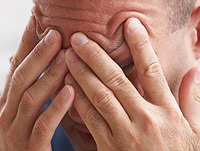There's a tendency to see sleep as a giant time suck - some unfortunate biological need to be kept at bay until someone's finished their English paper or beaten a tricky level on Candy Crush Saga.
Robert Wittig sees it differently.
"The only time you cannot possibly waste is when you're sleeping," said Wittig, medical director at the Aspirus Keweenaw Sleep Disorder Center in Laurium.
Perceiving those work, school or social demands as more important than a restful night is the leading cause of sleep deprivation, Wittig said.
A good night's sleep has been redefined downward over the past century as advances in technology and luminosity have extended shopping and recreation to a 24/7 distraction. The average person got nine hours of sleep a night in 1900; now, it's under seven.
"You can see that as a great improvement in human efficiency, or you can see it as a looming disaster," Wittig said. "Personally, as a child of the 60s, I think it might explain the loss of creativity in popular music."
But there's more to fear from drowsiness than Karmin. About two-thirds of single-vehicle accidents on the road are due to falling asleep, Wittig said.
"It probably wasn't a problem when people had horses, because you could fall asleep and the horse would still get you there," he said. "You're going down a highway in a car that's supposed to be comfortable, and a car that's supposed to be quiet and luxurious, you're more likely to fall asleep."
People operating on fewer hours of sleep will also have less initiative and be less efficient, he said.
When people come into the clinic, the first thing Wittig does is take the patient's case history. This can include what drugs they're taking, how often they have substances like alcohol or caffeine and their usual sleep environment.
Wittig once treated a woman from Detroit with terrible insomnia. She was admitted to the sleep center, where she had an uneventful, restful night. They were puzzled until she remarked on how warm it was. As it turns out, her house had no heat.
"That's why you literally have to spend an hour asking these questions, because something simple and obvious can end up being the problem," Wittig said.
About two-thirds of the people who come to the center wind up going through a sleep study. The three main measurements used are electromyography (muscle response), electroencephalography (electrical activity in the brain) and eye movement.
"With those three things, you can tell if a person's awake, asleep, what stage of sleep they're in," Wittig said.
Other tools can include an electrocardiogram, strain gauges on the chest, electrodes to measure restless legs and an oximeter to measure the oxygen saturation of hemoglobin in the blood.
But about a third of patients don't need a sleep study to find the remedy, said Wittig. He cautioned against overtreating patients when simpler solutions exist, using the example of a man who only snores when he drinks.
"As a male, half snore by the age of 50," he said. "It doesn't mean we all need sleep studies."
Some remedies are surgical.sSleep apnea, which causes snoring can be caused by obesity, or by large tonsils or a jaw defect; surgery can be used to open up the throat. Another route is continuous positive airway pressure, in which a machine blows air into a tube connecting to a mask that goes over the nose and mouth.
"Literally, that can be an overnight miracle for someone who got into a problem over years and didn't realize," Wittig said. "Overnight, they're a new person, and they think you're wonderful."
Read more here









